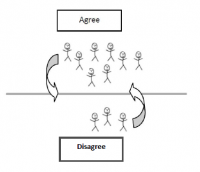Table of Contents

“Alike or not alike ?” Who should we partner with?
Objectives
- Bringing to light the PROs and CONs of working with partners that are pretty similar to us
- Learning from each other experiences and points of view
- Allowing everyone to express, with or without words
- Encouraging collective intelligence
Scenario
Duration: 35-40 minutes
Who could be an appropriate partner for you? Is it better to join forces with an organization which looks like yours, or not? A “moving discussion” can be a good way to address this complex topic.
First, draw a demarcation line on the ground and ask the participants to take position on a side or the other depending if the rather agree or disagree with the following statement: “A good partner is necessarily an organization that has the same ethics I have”.
Precise that they cannot stay on the demarcation line. The statement is voluntarily equivocal but they have to take position, knowing that they will be encouraged to move during the debate.
If they rather agree with the affirmation (i.e. if they think that “a good partner is necessarily an organization that has the same ethics they have”), they have to go to one side of the line (the “AGREE” area) ; if they disagree, they have to stand to the opposite side (the “DISAGREE” area).
 When everybody took position, ask one person from the side where there is the least people to express why he/she took this position. Then ask all the participants to move according to what was said. If they agree with the speaker’s opinion, they have to cross the line, or go closer to the speaker if they were already on the same side. If they disagree, they have to cross the demarcation line to go on the opposite side (or stay there if they were already on the opposite side).
Now you can let the other side speak and argue, by asking one volunteer to express. The idea is not to answer to the person who spoke just before, but to explain why they stand in the position they took. A good argument may deeply change the repartition of the participants around the demarcation line.
When everybody took position, ask one person from the side where there is the least people to express why he/she took this position. Then ask all the participants to move according to what was said. If they agree with the speaker’s opinion, they have to cross the line, or go closer to the speaker if they were already on the same side. If they disagree, they have to cross the demarcation line to go on the opposite side (or stay there if they were already on the opposite side).
Now you can let the other side speak and argue, by asking one volunteer to express. The idea is not to answer to the person who spoke just before, but to explain why they stand in the position they took. A good argument may deeply change the repartition of the participants around the demarcation line.
Start again the process for 25 to 30 minutes. People can change position as many times they want. The discussion continues as long as there is no consent, which means that some people still strongly disagree on what is discussed.
Material required
- 2 A4 to specify the meaning of the area (Agree or Disagree).
- A chalk, a string or some painter’s tape to draw the demarcation line
- A big room, for the participants to take position.
